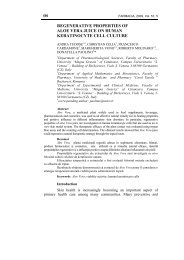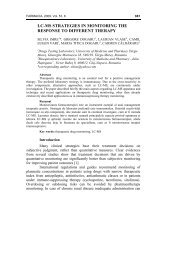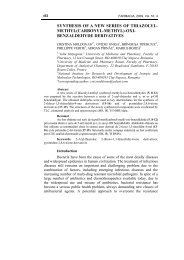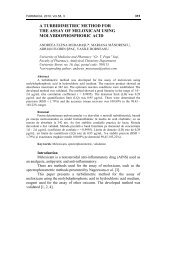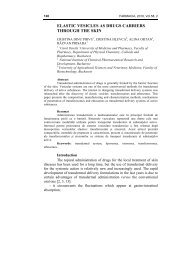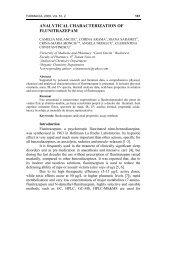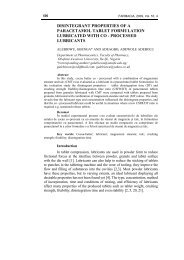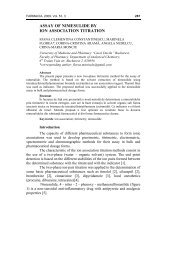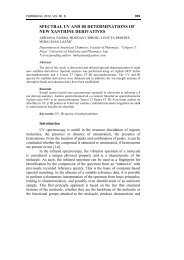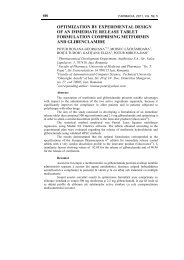development of a validated rp-hplc method for separation - farmacia
development of a validated rp-hplc method for separation - farmacia
development of a validated rp-hplc method for separation - farmacia
You also want an ePaper? Increase the reach of your titles
YUMPU automatically turns print PDFs into web optimized ePapers that Google loves.
534<br />
FARMACIA, 2009, Vol. 57, 5<br />
DEVELOPMENT OF A VALIDATED RP-HPLC<br />
METHOD FOR SEPARATION AND<br />
DETERMINATION OF PROCESS-RELATED<br />
IMPURITIES OF OMEPRAZOLE<br />
IN BULK DRUGS<br />
CRISTINA IUGA 1* , MARIUS BOJIŢĂ 1 , SORIN E. LEUCUŢA 2<br />
University <strong>of</strong> Medicine and Pharmacy „Iuliu Haţieganu”, Faculty <strong>of</strong><br />
Pharmacy, 400349, str. Louis Pasteur 6, Cluj Napoca, Romania<br />
1 Department <strong>of</strong> Drugs Analysis<br />
2 Department <strong>of</strong> Pharmaceutical Technology and Biopharmacy<br />
*corresponding author: iugac@umfcluj.ro<br />
Abstract<br />
A gradient reversed phase liquid chromatographic (RP-LC) <strong>method</strong> has been developed<br />
and subsequently <strong>validated</strong> <strong>for</strong> the determination <strong>of</strong> omeprazole and its process-related impurities<br />
(noted as: impurity A, B, C, D, G, H).. Separation was achieved with a Zorbax Extend C 18 column<br />
and acetonitrile: water: triethylamine1% (pH adjusted to 9.5) as eluent, at a flow rate <strong>of</strong> 0.8 mL/min.<br />
UV detection was per<strong>for</strong>med at 280 nm. The described <strong>method</strong> was linear over a range <strong>of</strong> 40.6-<br />
203µg/mL <strong>for</strong> omeprazol, 0.9556-14.334µg/mL <strong>for</strong> impurity A, 1.1568-17.352µg/mL <strong>for</strong> impurity<br />
B, 1.0772-16.158µg/mL <strong>for</strong> impurity C, 1.289-19.344 µg/mL <strong>for</strong> impurity D and 0.7968-<br />
11.952µg/mL <strong>for</strong> impurity H. The accuracy <strong>of</strong> the <strong>method</strong> has been demonstrated at 5 concentration<br />
levels in the range <strong>of</strong> 60–140% <strong>of</strong> the specification limit and the recovery <strong>of</strong> impurities was found to<br />
be in the range <strong>of</strong> 90–109%. The <strong>method</strong> is simple, rapid, selective, accurate and useful <strong>for</strong> indicating<br />
the stability <strong>of</strong> omeprazole from dosage <strong>for</strong>ms. The <strong>method</strong> can be useful in the quality control <strong>of</strong><br />
bulk manufacturing and pharmaceutical <strong>for</strong>mulations.<br />
Rezumat<br />
A fost elaborată şi validată o metodă RP-HPLC de separare şi determinare a<br />
omeprazolului şi impurităţilor sale de sinteză (notate astfel: impuritatea A, B, C, D, G, H).<br />
Separarea s-a realizat pe o coloană ZorbaxExtend C 18 cu o fază mobilă <strong>for</strong>mată din<br />
acetonitril: apa: trietilamină 1% (pH=9,5), cu un debit de 0,8 mL/min. Detecţia a fost UV la<br />
280nm. Metoda descrisă a fost lineară pe domeniul de concentraţii de 40,6-203µg/mL<br />
pentru omeprazol, 0,9556-14,334µg/mL pentru impuritatea A, 1,1568-17,352µg/mL pentru<br />
impuritatea B, 1,0772-16,158µg/mL pentru impuritatea C, 1,289-19,344 µg/mL pentru<br />
impuritatea D and 0,7968-11,952µg/mL pentru impuritatea H. Acurateţea metodei a fost<br />
demonstrată pentru 5 nivele de concentraţie în domeniul de 60–140% făţă de limitele<br />
specificate, gradul de regăsire pentru impurităţi a fost cuprins în domeniul 90–109%.<br />
Metoda este simplă, rapidă, selectivă, are acurateţe şi precizie, şi poate fi folosită şi pentru<br />
evaluarea stabilităţii omeprazolului în <strong>for</strong>me farmaceutice. Este o metodă utilă de control al<br />
purităţii omeprazolului din materia primă şi din <strong>for</strong>mele farmaceutice.<br />
Keywords: omeprazole; process-related impurities; RP-HPLC; validation
FARMACIA, 2009, Vol. 57, 5 535<br />
Introduction<br />
Omeprazole (OPZ), 5-methoxy-2-[[(4-methoxy-3,5-dimethyl-2-<br />
pyridinyl)methyl]sulphinyl]-1H-benzimidazole is a substituted benzimidazole<br />
compound and a prototype anti-secretory agent, being the first “proton pump<br />
inhibitor” widely used <strong>for</strong> the prophylaxis and treatment <strong>of</strong> gastro-duodenal<br />
ulcers and <strong>for</strong> the treatment <strong>of</strong> symptomatic gastro-oesophageal reflux. It acts<br />
by interacting with H + /K + ATPase in the secretory membranes <strong>of</strong> the parietal<br />
cells and is very effective in the treatment <strong>of</strong> Zollinger–Ellison syndrome.<br />
It is a lipophilic, weak base with pKa 1 = 4.2 and pKa 2 = 9 and can be<br />
degraded unless it is protected against acid conditions. OPZ contains a<br />
tricoordinated sulphur atom in a pyramidal structure and there<strong>for</strong>e can exist in two<br />
different optically active <strong>for</strong>ms, (S)- and (R)-omeprazole. OPZ was first approved<br />
as a racemic mixture, but the (S) isomer was recently introduced on the market [1].<br />
Few <strong>method</strong>s <strong>for</strong> the determination <strong>of</strong> the impurities either in bulk<br />
drugs or pharmaceuticals have been reported. In the last few years, it can be<br />
observed an increased interest <strong>for</strong> identification and quantification <strong>of</strong><br />
impurities in bulk drugs using new <strong>method</strong>ologies [2, 3].<br />
There are only a few analytical <strong>method</strong>s available in literature <strong>for</strong><br />
the determination <strong>of</strong> omeprazole and its related impurities (Fig. 1) in bulk<br />
drugs and pharmaceuticals [1,4,5].<br />
Thus, there is a need <strong>for</strong> the <strong>development</strong> <strong>of</strong> analytical <strong>method</strong>s,<br />
which will be useful <strong>for</strong> monitoring the levels <strong>of</strong> impurities in the finished<br />
products with omeprazole during process <strong>development</strong>.<br />
Experimental<br />
Materials<br />
Samples <strong>of</strong> omeprazole (batch nr. 90807/BA22347) and its related<br />
impurities - impurity A (batch nr. 17998/ BA20692), impurity B (batch nr.<br />
Rx935/BA20697), impurity C (batch nr. 310790/BA20693), impurity D<br />
(batch nr. 210997/BA22424), impurity G (batch nr. 321_E/BA20694) and<br />
impurity H (batch nr. AOP-324-1/BA22425) - were obtained from Union<br />
Quimica Farmaceutica, Barcelona, Spain. HPLC grade acetonitrile,<br />
triethylamine and orthophos<strong>for</strong>ic acid 85% were obtained from Merck,<br />
Darmstadt, Germany. LC grade water was deionized with Milli-Q and then<br />
filtered using Milli-Q Academic, Millipore water purification system<br />
(Mil<strong>for</strong>d, MA, USA). All other reagents were <strong>of</strong> analytical grade purity.<br />
Equipment<br />
The LC system, HPLC Agilent Series 1100, consisted <strong>of</strong> binary<br />
gradient pump, autosampler, column oven and a UV detector. The output<br />
signal was monitored and integrated using HP Chemstation s<strong>of</strong>tware.
536<br />
FARMACIA, 2009, Vol. 57, 5<br />
Figure 1<br />
Chemical structures <strong>of</strong> omeprazole and its process-related impurities<br />
Solutions<br />
Mobile phase.<br />
A. Water: triethylamine 1% pH adjusted to 9.5 with 85%, w/v<br />
H 3 PO 4 and acetonitrile in ratio (90:10v/v). It was filtered through a 0.45 µm<br />
nylon membrane filter prior to use and degassed <strong>for</strong> 15 min.<br />
B. Acetonitrile<br />
Dilution Solution. A mixture <strong>of</strong> sodium tetraborat 0.01M and<br />
acetonitrile in ratio (3:1 v/v)
FARMACIA, 2009, Vol. 57, 5 537<br />
Impurities standard solutions. 0.5mg/mL impurities stock<br />
standard solutions were prepared in methanol. These solutions were kept at<br />
+4°C, protected from light. In these conditions the solutions were stable <strong>for</strong><br />
two months. Working solutions were prepared by dilution to a concentration<br />
<strong>of</strong> 1 µg/mL and injected into the system.<br />
Omeprazole standard solution. 1.015mg/mL omeprazole stock<br />
standard solution was prepared in methanol and was kept at +4°C, protected<br />
from light. In these conditions it was stable <strong>for</strong> two months. Omeprazole<br />
working solutions were prepared by dilution using previously prepared<br />
impurities solutions at concentrations between 40-200µg/mL and injected<br />
into the system.<br />
Sample solution. 2mg/mL solution <strong>of</strong> omeprazole sample was<br />
prepared in methanol and diluted to a concentration <strong>of</strong> 0.200µg/mL and<br />
injected into the system.<br />
Forced degradation samples <strong>for</strong> the specificity study.<br />
Omeprazole was kept in a climatic chamber at 40±5°C, 75±5%<br />
humidity and was exposed to artificial light <strong>for</strong> 6 months to study the<br />
<strong>for</strong>mation <strong>of</strong> the degradation products. Every two weeks, an omeprazole<br />
sample was withdrawn from the climatic chamber to per<strong>for</strong>m the analyse.<br />
Chromatographic conditions. A Zorbax Extend C 18 analytical<br />
column (150mm×4.6 mm, 5µm packing) (Agilent) was used <strong>for</strong> analysis at<br />
25°C. The mobile phase was pumped through the column at a flow rate <strong>of</strong><br />
0.8 mL/min. Gradient program was: 0min(18%B), 7.2min(18%B),<br />
10.5min(50%B), 12min(50%B), 16min(18%B) and 18min(18%B). The<br />
sample injection volume was 20µL. The UV detector was set to a<br />
wavelength <strong>of</strong> 280 nm <strong>for</strong> the detection.<br />
Results and discussion<br />
Method <strong>development</strong><br />
In order to develop a suitable and robust LC <strong>method</strong> <strong>for</strong> the<br />
determination <strong>of</strong> omeprazole and its process-related impurities, different<br />
mobile phases and columns were employed to achieve the best <strong>separation</strong><br />
and resolution. Finally, the mobile phase consisting <strong>of</strong> water:triethylamine<br />
1% pH adjusted to 9.5 with 85% H 3 PO 4 and acetonitrile at a flow rate <strong>of</strong> 0.8<br />
mL/min, using a ZorbaxExtend C 18 (150mm×4.6mm, 5µm) column was<br />
found to be appropriate, allowing good <strong>separation</strong> <strong>of</strong> omeprazole and its<br />
process-related impurities. Because, the impurity D and the impurity G were<br />
not separated in the described chromatographic conditions, we choose to use<br />
only impurity D along with others impurities in future analysis. The reason
538<br />
FARMACIA, 2009, Vol. 57, 5<br />
<strong>for</strong> this choice is because it is a higher probability to find impurity D than<br />
impurity G as degradation product in time.<br />
Omeprazole and its process-related impurities show significant UV<br />
absorbance at the wavelength <strong>of</strong> 280nm. Hence, this wavelength has been<br />
chosen <strong>for</strong> detection.<br />
Method validation<br />
Specificity. In the above conditions, impurity A eluted first<br />
followed by impurities D, B, omeprazole, H and C. The chromatogram<br />
showing the <strong>separation</strong> <strong>of</strong> omeprazole and all its process-related impurities<br />
is shown in Fig. 2.<br />
Figure 2<br />
The chromatogram <strong>of</strong> omeprazole and its impurities (standard solutions)<br />
Linearity. Calibration curves were per<strong>for</strong>med in the following<br />
concentration ranges: <strong>for</strong> omeprazol (40.6-203 µg/mL), impurity A (0.9556-<br />
14.334 µg/mL), impurity B (1.1568-17.352 µg/mL), impurity C (1.0772-<br />
16.158 µg/mL), impurity D (1.289-19.344 µg/mL) and impurity H (0.7968-<br />
11.952 µg/mL). The parameters <strong>of</strong> linearity curves are shown in table I.<br />
Table I<br />
Parameters <strong>of</strong> linearity curves <strong>of</strong> omeprazole and its impurities<br />
Slope<br />
(b)<br />
Intercept<br />
(a)<br />
r Limit <strong>of</strong> detection (LOD )<br />
(µg/mL)<br />
Omeprazole 39.210 -29.414 0.9997 0.70<br />
Impurity A 30.397 -12.095 0.9998 0.40<br />
Impurity B 57.505 -14.112 0.9992 0.20<br />
Impurity C 36.713 -18.166 0.9998 0.50<br />
Impurity D 39.920 -1.554 0.9999 0.03<br />
Impurity H 46.287 -10.037 0.9989 0.20
FARMACIA, 2009, Vol. 57, 5 539<br />
Accuracy. The accuracy <strong>of</strong> the analytical <strong>method</strong> was evaluated by<br />
analysing standard solutions <strong>of</strong> omeprazole and its related impurities at five<br />
concentration levels. The obtained values are reported in Table II.<br />
Compound<br />
Omeprazole<br />
Impurity A<br />
Impurity B<br />
Impurity C<br />
Impurity D<br />
Impurity H<br />
Theoretical<br />
concentration<br />
(µg/mL)<br />
Calculated<br />
concentration<br />
µg/mL ±SD<br />
Table II<br />
Accuracy <strong>of</strong> omeprazole and its impurities<br />
Recovery % Accuracy<br />
±SD<br />
%<br />
40.60 41.28 ± 0.03 101.67 ± 0.06 1.67<br />
81.20 83.69 ± 0.56 103.07 ± 0.69 3.07<br />
121.80 122.35 ± 0.53 100.45 ± 0.43 0.45<br />
162.40 165.96 ± 0.61 102.19 ± 0.38 2.19<br />
203.00 206.50 ± 0.58 101.72 ± 0.28 1.72<br />
0.96 1.0 ± 0.03 109.18 ± 3.02 9.18<br />
1.91 1.89 ± 0.15 99.13 ± 7.86 -0.87<br />
3.82 3.90 ± 0.17 102.09 ± 4.37 2.09<br />
7.64 7.11 ± 0.03 93.02 ± 0.38 -6.98<br />
14.33 14.27 ± 0.05 99.58 ± 0.36 -0.42<br />
1.15 1.15 ± 0.01 100.29 ± 1.00 0.29<br />
2.13 2.13 ± 0.02 100.16 ± 0.98 0.16<br />
4.62 4.52 ± 0.01 97.84 ± 0.22 -2.16<br />
9.25 9.20 ± 0.05 99.46 ± 0.56 -0.54<br />
17.35 17.33 ± 0.02 99.90 ± 0.09 -0.10<br />
1.07 1.05 ± 0.03 98.13 ± 2.80 -1.87<br />
2.15 2.15 ± 0.04 100.16 ± 1.76 0.16<br />
4.30 4.33 ± 0.02 100.62 ± 0.36 0.62<br />
8.61 8.51 ± 0.08 98.80 ± 0.93 -1.20<br />
16.15 16.22 ± 0.02 100.45 ± 0.09 0.45<br />
1.28 1.17 ± 0.02 91.41 ± 1.35 -8.59<br />
2.52 2.46 ± 0.02 97.62 ± 0.69 -2.38<br />
5.15 5.12 ± 0.02 99.42 ± 0.34 -0.58<br />
10.31 10.32 ± 0.03 100.06 ± 0.31 0.06<br />
19.34 19.30 ± 0.11 99.79 ± 0.58 -0.21<br />
0.79 0.86 ± 0.07 108.86 ± 8.77 8.86<br />
1.59 1.62 ± 0.04 101.68 ± 2.38 1.68<br />
3.18 2.93 ± 0.03 92.03 ± 0.79 -7.97<br />
6.37 6.27 ± 0.02 98.38 ± 0.33 -1.62<br />
11.95 12.24 ± 0.69 102.45 ± 5.77 2.45<br />
Precision. The precision <strong>of</strong> the analytical <strong>method</strong> was evaluated by<br />
analysing standard solutions <strong>of</strong> omeprazole and its related impurities at<br />
100% level. The obtained values <strong>for</strong> intra-day precision are reported in<br />
Table III and <strong>for</strong> inter-day precision are reported in Table IV.
540<br />
FARMACIA, 2009, Vol. 57, 5<br />
Compound<br />
Table III<br />
Intra-day precision <strong>of</strong> the RP-HPLC <strong>method</strong>,<br />
evaluated by analysing standard solutions <strong>of</strong> omeprazole and its impurities<br />
Theoretical<br />
concentration<br />
(µg/mL)<br />
Calculated<br />
concentration<br />
µg/mL ±SD<br />
CV %<br />
Omeprazole 121.80 121.74 ± 0.105 0.12<br />
Impurity A 3.82 4.07 ± 0.007 0.18<br />
Impurity B 4.62 4.53 ± 0.008 0.29<br />
Impurity C 4.30 3.74 ± 0.010 0.26<br />
Impurity D 5.15 5.07 ± 0.005 0.13<br />
Impurity H 3.18 2.70 ± 0.009 0.34<br />
Compound<br />
Table IV<br />
Inter-day precision <strong>of</strong> the RP-HPLC <strong>method</strong>,<br />
evaluated by analysing standard solutions <strong>of</strong> omeprazole and its impurities<br />
Theoretical<br />
concentration<br />
(µg/mL)<br />
Calculated<br />
concentration<br />
µg/mL ±SD<br />
CV %<br />
Omeprazole 121.80 121.905 ± 0.479 0.39<br />
Impurity A 3.82 4.131 ± 0.049 1.20<br />
Impurity B 4.62 4.539 ± 0.016 0.35<br />
Impurity C 4.30 3.828 ± 0.101 2.66<br />
Impurity D 5.15 5.109 ± 0.028 0.55<br />
Impurity H 3.18 2.715 ± 0.038 1.42<br />
Limit <strong>of</strong> detection (LOD). Limits <strong>of</strong> detection <strong>for</strong> omeprazole and<br />
its impurities were calculated based on the signal to noise ratio (S/N=10σ),<br />
and were between 0.7µg/mL and 0.03 µg/mL, being presented in table I.<br />
Limit <strong>of</strong> quantification (LOQ). Limits <strong>of</strong> quantitation <strong>for</strong><br />
omeprazole and its impurities were calculated based on the signal to noise<br />
ratio (S/N=10σ), and were the following: omeprazole (2.331µg/mL),<br />
impurity A (3.331µg/mL), impurity B (0.666µg/mL), impurity C<br />
(1.665µg/mL), impurity D (0.099µg/mL), impurity H (0.666µg/mL).<br />
Conclusion<br />
A gradient reversed phase HPLC <strong>method</strong> has been developed and<br />
<strong>validated</strong> <strong>for</strong> the determination <strong>of</strong> omeprazole and its process-related impurities<br />
from bulk drug. This chromatographic assay fulfilled all the requirements <strong>for</strong><br />
being a reliable and feasible <strong>method</strong>, including accuracy, linearity, recovery<br />
and precision. It is a highly specific and precise analytical procedure.<br />
There<strong>for</strong>e, this HPLC <strong>method</strong> can be used as a routine sample<br />
analysis.
FARMACIA, 2009, Vol. 57, 5 541<br />
Acknowledgements<br />
The authors would like to acknowledge the help <strong>of</strong> Union Quimica<br />
Farmaceutica, Barcelona, <strong>for</strong> providing process-related impurities <strong>of</strong><br />
omeprazole.<br />
References<br />
1. Espinosa Bosh M, Ruiz Sanchez A.J., Sanchez Rojas F., Bosch Ojeda C.<br />
Analytical <strong>method</strong>ologies <strong>for</strong> the determination <strong>of</strong> omeprazole: An overview.<br />
Journal <strong>of</strong> Pharmaceutical and Biomedical Analysis 2007; 44: 831–844.<br />
2. Varvara A., Monciu C.M, Arama C., Popescu C. The HPLC assay <strong>of</strong><br />
ondansetron hydrochloride and its impurities using a new stationary phase.<br />
Farmacia 2008; 56 (2):154-165.<br />
3. Constantinescu D., Curea E. Reversed phase high per<strong>for</strong>mance liquid<br />
chromatography (RP-HPLC) determination <strong>of</strong> lisinopril and its degradation<br />
products in stability and compatibility studies. Farmacia 2008; 56 (1) :50-56.<br />
4. Iuga C., Moldovan M., Popa A., Leucuţa S.E. Validation <strong>of</strong> HPLC-UV<br />
<strong>method</strong> <strong>for</strong> analysis <strong>of</strong> omeprazole in presence <strong>of</strong> its metabolites in human<br />
plasma. Farmacia, 2008, 56 (3): 254-260.<br />
5. Ribani M, Collins CH, Bottoli CB. Validation <strong>of</strong> chromatographic <strong>method</strong>s:<br />
evaluation <strong>of</strong> detection and quantification limits in the determination <strong>of</strong><br />
impurities in omeprazole. J Chromatogr A. 2007; (1156) 1-2:201-205.<br />
___________________________<br />
Manuscript received: 25.03.2009



